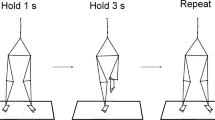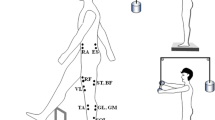Abstract
We used the framework of the uncontrolled manifold hypothesis to explore the effects of practice on the composition of muscle groups (M-modes) and multi-M-mode synergies stabilizing the location of the center of pressure (COP). In particular, we tested a hypothesis that practice could lead to a transition from co-contraction muscle activation patterns to reciprocal patterns. We also tested a hypothesis that new sets of M-modes would form stronger synergies stabilizing COP location. Subjects practiced load release tasks for five days while standing on a board with a narrow support surface (unstable board). Their M-modes and indices of multi-M-mode synergies were computed during standing without instability and during standing on an unstable board before practice, in the middle of practice, and at the end of practice. During standing without instability, subjects showed two consistent M-modes uniting dorsal and ventral muscles of the body respectively (reciprocal modes). While standing on an unstable board, prior to practice, subjects commonly showed M-modes uniting muscle pairs with opposing actions at major leg joints—co-contraction modes. Such sets of M-modes failed to stabilize the COP location in the anterior-posterior direction. Practice led to better task performance reflected in fewer incidences of lost balance. This was accompanied by a drop in the occurrence of co-contraction M-modes and the emergence of multi-mode synergies stabilizing the COP location. We conclude that the central nervous system uses flexible sets of elemental variables (modes) to ensure stable trajectories of important performance variables (such as COP location). Practice can lead to adjustments in both the composition of M-modes and M-mode co-variation patterns resulting in stronger synergies stabilizing COP location.









Similar content being viewed by others
References
Aruin AS, Latash ML (1996) Anticipatory postural adjustments during self-initiated perturbations of different magnitude triggered by a standard motor action. Electroencephalogr Clin Neurophysiol 101:497–503
Belen’kii VY, Gurfinkel VS, Paltsev YI (1967) Elements of control of voluntary movements. Biofizika 12:135–141
Bernstein NA (1967) The coordination and regulation of movements. Pergamon Press, London
Bernstein NA (1996) On dexterity and its development. In: Latash ML, Turvey MT (eds) Dexterity and its development. Erlbaum Publ., Mahwah, pp 3–246
Corcos DM, Gottlieb GL, Latash ML, Almeida GL, Agarwal GC (1992) Electromechanical delay: an experimental artefact. J Electromyogr Kinesiol 2:59–68
Danion F, Latash ML, Li ZM, Zatsiorsky VM (2000) The effect of fatigue on multifinger co-ordination in force production tasks in humans. J Physiol 523:523–532
Danion F, Latash ML, Li ZM, Zatsiorsky VM (2001) The effect of a fatiguing exercise by the index finger on single- and multi-finger force production tasks. Exp Brain Res 138:322–329
Danion F, Schöner G, Latash ML, Li S, Scholz JP, Zatsiorsky VM (2003) A mode hypothesis for finger interaction during multi-finger force-production tasks. Biol Cybern 88:91–98
Danna-Dos-Santos A, Slomka K, Zatsiorsky VM, Latash ML (2007) Muscle modes and synergies during voluntary body sway. Exp Brain Res 179:533–550
D’Avella A, Saltiel P, Bizzi E (2003) Combinations of muscle synergies in the construction of a natural motor behavior. Nat Neurosci 6:300–308
D’Avella A, Bizzi E (2005) Shared and specific muscle synergies in natural motor behaviors. Proc Natl Acad Sci USA 102:3076–3081
Domkin D, Laczko J, Jaric S, Johansson H, Latash ML (2002) Structure of joint variability in bimanual point tasks. Exp Brain Res 143:11–23
Domkin D, Laczko J, Djupsjobacka M, Jaric S, Latash ML (2005) Joint angle variability in 3D bimanual pointing: uncontrolled manifold analysis. Exp Brain Res 163:44–57
Gelfand IM, Latash ML (1998) On the problem of adequate language in motor control. Motor Control 2:306–313
Gelfand IM, Latash ML (2002) On the problem of adequate language in biology. In: Latash ML (ed) Progress in motor control. Structure-function relations in voluntary movement, vol 2. Human Kinetics, Urbana, pp 209–228
Gelfand IM, Tsetlin ML (1966) On mathematical modeling of the mechanisms of the center nervous system. In: Gelfand IM, Gurfinkel VS, Fogt N, Tsetlin ML (eds) Models of the structural-functional organization of certain biological systems. Nauka, Moscow, pp 9–26
Hair JF, Anderson RE, Tatham RL, Black WC (1995) Factor analysis. In: Borkowsky D (ed) Multivariate data analysis, Prentice-Hall, Englewood Cliffs, NJ, pp 364–404
Hatzitaki V, Amiridis IG, Arabatzi F (2005) Aging effects on postural responses to self-imposed balance perturbations. Gait Posture 22:250–257
Ioffe ME, Ustinova KI, Chernikova LA, Kulikov MA (2006) Supervised learning of postural tasks in patients with poststroke hemiparesis, Parkinson’s disease or cerebellar ataxia. Exp Brain Res 168:384–394
Ivanenko YP, Poppele RE, Lacquaniti F (2004) Five basic muscle activation patterns account for muscle activity during human locomotion. J Physiol 556:267–282
Ivanenko YP, Cappellini G, Dominici N, Poppele RE, Lacquaniti F (2005) Coordination of locomotion with voluntary movements in humans. J Neurosci 25:7238–7253
Kang N, Shinohara M, Zatsiorsky VM, Latash ML (2004) Learning multi-finger synergies: an uncontrolled manifold analysis. Exp Brain Res 157:336–350
Krishnamoorthy V, Goodman S, Zatsiorsky VM, Latash ML (2003a) Muscle synergies during shifts of the center of pressure by standing persons: identification of muscle modes. Biol Cybern 89:152–161
Krishnamoorthy V, Latash ML, Scholz JP, Zatsiorsky VM (2003b) Muscle synergies during shifts of the center of pressure by standing persons. Exp Brain Res 152:281–292
Krishnamoorthy V, Latash ML, Scholz JP, Zatsiorsky VM (2004) Muscle modes during shifts of the center of pressure by standing persons: effect of instability and additional support. Exp Brain Res 157:18–31
Latash ML, Scholz JP, Danion F, Schöner G (2001) Structure of motor variability in marginally redundant multifinger force production tasks. Exp Brain Res 41:153–165
Latash ML, Scholz JP, Schöner G (2002) Motor control strategies revealed in the structure of motor variability. Exer Sport Sci Rev 30:26–31
Latash ML, Yarrow K, Rothwell JC (2003) Changes in finger coordination and responses to single pulse TMS of motor cortex during practice of a multifinger force production task 151:60–71
Latash ML, Anson JG (2006) Synergies in health and disease: relations to adaptive changes in motor coordination. Phys Ther 86:1151–1160
Latash ML, Scholz JP, Schöner G (2007) Toward a new theory of motor synergies. Motor Control 11:275–307
Li ZM, Latash ML, Zatsiorsky VM (1998) Force sharing among fingers as a model of the redundancy problem. Exp Brain Res 19:276–286
Loeb EP, Giszter SF, Saltiel P, Bizzi E, Mussa-Ivaldi FA (2000) Output units of motor behavior: an experimental and modeling study. J Cogn Neurosci 12:78–97
Newell KM, Broderick MP, Deutsch KM, Slifkin AB (2003) Task goals and change in dynamical degrees of freedom with motor learning. J Exp Psychol: Hum Percept Perform 29:379–87
Olafsdottir H, Yoshida N, Zatsiorsky VM, Latash ML (2005) Anticipatory covariation of finger forces during self-paced and reaction time force production. Neurosci Lett 381:92–96
Saltiel P, Wyler-Duda K, D’Avella A, Tresch MC, Bizzi E (2001) Muscle synergies encoded within the spinal cord: evidence from focal intraspinal NMDA tophoresis in the frog. J Neurophysiol 85:605–619
Schmidt RA (2004) Motor learning and performance. Human Kinetics, Champaign
Shim JK, Olafsdottir H, Zatsiorsky VM, Latash ML (2005) The emergence and disappearance of multi-digit synergies during force-production tasks. Exp Brain Res 164:260–270
Scholz JP, Schöner G (1999) The uncontrolled manifold concept: identifying control variables for a functional task. Exp Brain Res 126:289–306
Scholz JP, Danion F, Latash ML, Schöner G (2002) Understanding finger coordination through analysis of the structure of force variability. Biol Cybern 86:29–39
Shiratori T, Latash M (2000) The roles of proximal and distal muscles in anticipatory postural adjustments under asymmetrical perturbations and during standing on rollerskates. Clin Neurophysiol 111:613–623
Shiratori T, Aruin A (2007) Modulation of anticipatory postural adjustments associated with unloading perturbation: effect of characteristics of a motor action. Exp Brain Res 178:206–215
Ting LH, Macpherson JM (2005) A limited set of muscle synergies for force control during a postural task. J Neurophysiol 93:609–613
Tresch MC, Cheung VC, D’Avela A (2006) Matrix factorization algorithms for the identification of muscle synergies: evaluation of simulated and experimental data sets. J Neurophysiol 95:2199–212
Vereijken B, van Emmerick REA, Whiting HTA, Newell KM (1992) Free(z)ing degrees of freedom in skill acquisition. J Mot Behav 24:133–142
Wang Y, Zatsiorsky VM, Latash ML (2005) Muscle synergies involved in shifting the center of pressure while making a first step. Exp Brain Res. 167:196–210
Wang Y, Asaka T, Zatsiorsky VM, Latash ML (2006) Muscle synergies during voluntary body sway: combining across-trials and within-a-trial analyses. Exp Brain Res 174:679–693
Weiss EJ, Flanders M (2004) Muscular and postural synergies of the human hand. J Neurophysiol 92:523–535
Zatsiorsky VM, Li ZM, Latash ML (2000) Enslaving effects in multi-finger force production. Exp Brain Res 131:187–195
Acknowledgments
This work was supported in part by the Japanese Ministry of Education and Science (18500394) and by a National Institutes of Health (USA) grant NS-035032.
Author information
Authors and Affiliations
Corresponding author
Rights and permissions
About this article
Cite this article
Asaka, T., Wang, Y., Fukushima, J. et al. Learning effects on muscle modes and multi-mode postural synergies. Exp Brain Res 184, 323–338 (2008). https://doi.org/10.1007/s00221-007-1101-2
Received:
Accepted:
Published:
Issue Date:
DOI: https://doi.org/10.1007/s00221-007-1101-2




